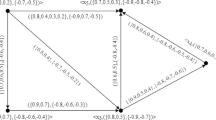Abstract
Set relations and operations such as inclusion, union and intersection are generalized to directed subsets whose elements are distinguished between forward and backward elements. The concepts of submodular functions, matroids and polymatroidal network flows are extended to the concepts of directed submodular functions, ditroids and directed submodular flows on directed subsets. Two unrelated matroids (submodular functions) can be embedded in one ditroid (directed submodular function). Total dual integrality is preserved in these generalizations and proved for very general set-function class-directed odd submodular functions.
Similar content being viewed by others
References
R. Bixby, “Matroids and operations research,” in: H.J. Greenberg, F.H. Murphy and S.H. Shaw, eds.,Advanced Techniques in the Practice of Operations Research (North-Holland, New York, 1981) pp. 333–458.
R.G. Bland, “A combinatorial abstraction of linear programming,”Journal of Combinatorial Theory Series B 23 (1977) 33–57.
R.G. Bland and M. Las Vergnas, “Orientability of matroids,”Journal of Combinatorial Theory Series B 24 (1978) 94–123.
W. Cook, “On box totally dual integral polyhedra,”Mathematical Programming 34 (1986) 64–69.
W.H. Cunningham and F. Barahona, “A submodular network simplex method,”Mathematical Programming Study 22 (1984) 9–31.
W.H. Cunningham and A. Frank, “A primal-dual algorithm for submodular flows,”Mathematics of Operations Research 10 (1985) 251–262.
J. Edmonds, “Submodular functions, matroids, and certain polyhedra,” in: R. Guy, H. Hanani, N. Sauer and J. Schönheim, eds.,Combinatorial Structures and Their Applications (Gordon and Breach, New York, 1970) pp. 69–87.
J. Edmonds and R. Giles, “A min-max relation on submodular functions on graph,”Annals of Discrete Mathematics 1 (1977) 185–204.
J. Edmonds and R. Giles, “Total dual integrality of linear inequality systems,” in: W.R. Pulleyblank, ed.,Progress in Combinatorial Optimization (Academic Press, New York, 1984) pp. 117–129.
M.L. Fisher, G.L. Nemhauser and L.A. Wolsey, “An analysis of approximations for maximizing submodular set functions II,”Mathematical Programming Study 8 (1978) 73–87.
A. Frank, “An algorithm for submodular functions on graphs,”Annals of Discrete Mathematics 16 (1982) 97–120.
A. Frank, “Finding feasible vectors of Edmonds-Giles polyhedra,”Journal of Combinatorial Theory Series B 36 (1984) 221–239.
A. Frank, “Submodular flows,” in: W.R. Pulleyblank, ed.,Progress in Combinatorial Optimization (Academic Press, New York, 1984) pp. 147–166.
S. Fujishige, “Canonical decompositions of symmetric submodular systems,”Discrete Applied Mathematics 5 (1983) 175–190.
S. Fujishige, “Structures of polyhedra determined by submodular functions on crossing families,”Mathematical Programming 29 (1984) 125–141.
S. Fujishige, “Theory of submodular programs: A Fenchel-type min-max theorem and subgradients of submodular functions,”Mathematical Programming 29 (1984) 142–155.
S. Fujishige, “On the subdifferential of a submodular function,”Mathematical Programming 29 (1984) 348–360.
S. Fujishige, “Submodular systems and related topics,”Mathematical Programming Study 22 (1984) 113–131.
S. Fujishige, “Combinatorial optimization problems described by submodular functions,” in: J.P. Brans, ed.,Operational Research '84 (North-Holland, New York, 1984) pp. 379–392.
S. Fujishige, “A system of linear inequalities with a submodular function on {0, ±1} vectors,”Linear Algebra and Its Applications 63 (1984) 253–266.
A. Ghouila-Houri, “Caracterisation des matrices totalement unimodulaires,”C.R. Acad. Sci. Paris 254 (1962) 1192–1194.
R. Hassin, “Minimum cost flow with set constraints,”Networks 12 (1982) 1–21.
B. Korte and L. Lovász, “Greedoids—a structural framework for the greedy algorithm,” in: W.R. Pulleyblank, ed.,Progress in Combinatorial Optimization (Academic Press, New York, 1984) pp. 221–243.
M. Las Vergnas, “Convexity in oriented matroids,”Journal of Combinatorial Theory Series B 29 (1980) 231–243.
E.L. Lawler, “Submodular functions and polymatroid optimization,” in M. O'hEigeartaigh, J.K. Lenstra and A.H.G. Rinnooy Kan, eds.,Combinatorial Optimization—Annotated Bibliographies (John Wiley & Sons, New York, 1985) pp. 32–38.
E.L. Lawler and C.U. Martel, “Computing ‘maximal’ polymatroidal network flows,”Mathematics of Operations Research 7 (1982) 334–347.
E.L. Lawler and C.U. Martel, “Flow network formulation of polymatroid optimization problem,”Annals of Discrete Mathematics 16 (1982) 189–200.
L. Lovász, “Submodular functions and convexity,” in: A. Bachem, M. Grötschel and B. Korte, eds.,Mathematical Programming: the State of the Art—Bonn 1982 (Springer-Verlag, Berlin, 1983) pp. 235–257.
G.L. Nemhauser, L.A. Wolsey and M.L. Fisher, “An analysis of approximations for maximizing submodular set functions I,”Mathematical Programming 14 (1978) 265–294.
L. Qi, “Odd submodular functions, Dilworth functions and discrete convex functions,”Mathematics of Operations Research 13 (1988).
A. Schrijver, “Min-max results in combinatorial optimization,” in: A. Bachem, M. Grötschel and B. Korte, eds.,Mathematical Programming: The State of the Art—Bonn 1982 (Springer-Verlag, Berlin, 1983) pp. 439–500.
A. Schrijver, “Total dual integrality from directed graphs, crossing families, and sub- and supermodular functions,” in: W. Pulleyblank, ed.,Progress in Combinatorial Optimization (Academic Press, New York, 1984) pp. 315–361.
P.D. Seymour, “Decomposition of regular matroids,”Journal of Combinatorial Theory Series B 28 (1980) 305–359.
D.J.A. Welsh,Matroid Theory (Academic Press, New York, 1976).
L.A. Wolsey, “Maximizing real-valued submodular functions: Primal and dual heuristics for location problems,”Mathematics of Operations Research 7 (1982) 410–425.
U. Zimmermann, “Minimization of some nonlinear functions over polymatroidal flows,”Annals of Discrete Mathematics 16 (1982) 287–302.
U. Zimmermann, “Minimization on submodular flows,”Discrete Applied Mathematics 4 (1982) 302–323.
U. Zimmermann, “Minimization of combined objective functions on integral submodular functions,”Annals of Discrete Mathematics 19 (1984) 363–382.
Author information
Authors and Affiliations
Additional information
This work was partially supported by Chinese National Natural Science Fund.
Rights and permissions
About this article
Cite this article
Qi, L. Directed submodularity, ditroids and directed submodular flows. Mathematical Programming 42, 579–599 (1988). https://doi.org/10.1007/BF01589420
Received:
Revised:
Issue Date:
DOI: https://doi.org/10.1007/BF01589420




